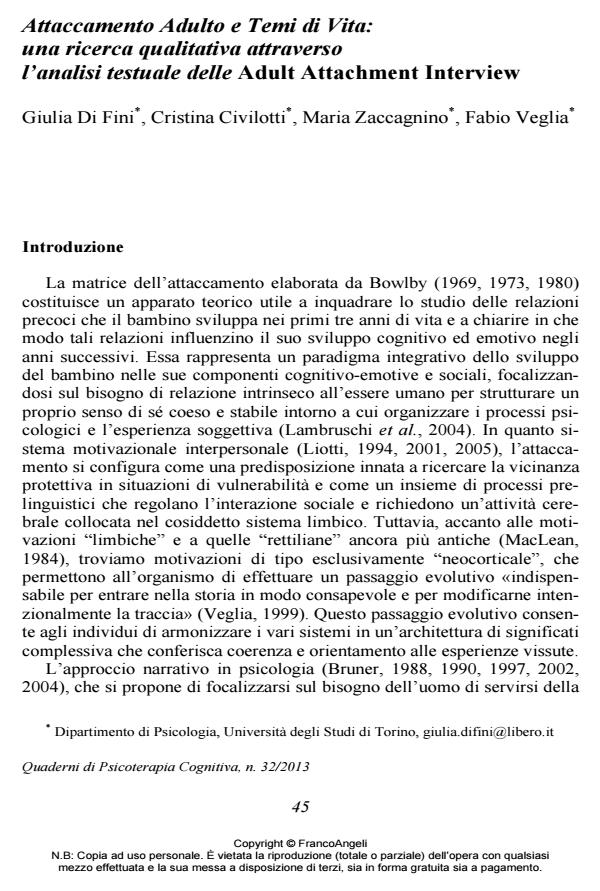Adult Attachment and Life Themes: A qualitative survey through the textual analysis on Adult Attachment Interview
Journal title QUADERNI DI PSICOTERAPIA COGNITIVA
Author/s Giulia Di Fini, Cristina Civilotti, Maria Zaccagnino, Fabio Veglia
Publishing Year 2013 Issue 2013/32
Language Italian Pages 16 P. 45-60 File size 402 KB
DOI 10.3280/QPC2013-032004
DOI is like a bar code for intellectual property: to have more infomation
click here
Below, you can see the article first page
If you want to buy this article in PDF format, you can do it, following the instructions to buy download credits

FrancoAngeli is member of Publishers International Linking Association, Inc (PILA), a not-for-profit association which run the CrossRef service enabling links to and from online scholarly content.
The narrative approach in psychology involves the theoretical model of the autobiographical construction of life-themes. Veglia’s conceptualization (1999, 2006) postulates the existence of six Life-Themes (Love, Value, Power, Freedom, Truth and Death) that develop trough interpersonal relationships and remain consistent across cultures. They work as meaning organizers around which individuals construct their personal experiences. Early attachment relationship creates the conditions that enable all the other relationships in the life course. In fact first cognitive and emotional structures develop in interpersonal representations and autobiographical memories mediated by attachment system (Bowlby 1969/1982). The aim of this pilot study was to investigate the presence of these six Life-Themes and how they recur within and across Adult Attachment Interview (AAI) transcripts. Linguistic choices and Life-Themes were analyzed with a qualitative methodology. Fifteen AAI transcripts were analyzed at two levels: (a) thematic text analysis to find what sub-themes emerge from narratives by coding meaningful units of text; (b) semantic text analysis to specify the nature of relations among Life-Themes and sub-themes by demonstrating the network of meaning within the data. Codification and interview analyses have been carried out using ATLAS.ti software. The association between Life-Themes and AAI categories was examined from an explorative view. Data have corroborate the existence of Life-Themes linked to personal attachment histories. Results showed twenty sub-themes, each of which was characterized by reciprocal links. Limitations and future directions of the study will be discussed.
Keywords: Narrative themes, attachment, Adult Attachment Interview, autobiography, qualitative research
- Narrative and Bodily Identity in Eating Disorders: Toward an Integrated Theoretical-Clinical Approach Rosa Antonella Pellegrini, Sarah Finzi, Fabio Veglia, Giulia Di Fini, in Frontiers in Psychology 785004/2021
DOI: 10.3389/fpsyg.2021.785004
Giulia Di Fini, Cristina Civilotti, Maria Zaccagnino, Fabio Veglia, Attaccamento Adulto e Temi di Vita: una ricerca qualitativa attraverso l’analisi testuale delle Adult Attachment Interview in "QUADERNI DI PSICOTERAPIA COGNITIVA" 32/2013, pp 45-60, DOI: 10.3280/QPC2013-032004